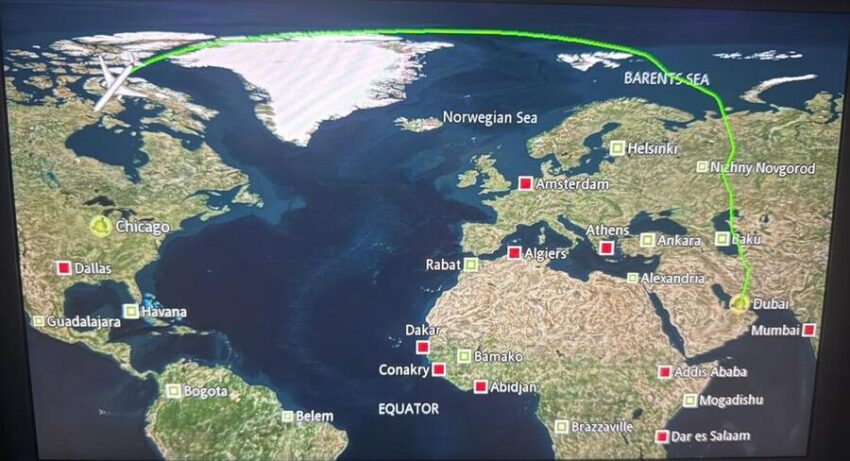- by foxnews
- 17 Mar 2025
Emirates, FlyDubai, Etihad, and Qatar Airways Adjust Routes in the Middle East, Avoiding Iraq-Turkey War Zones: New Travel Updates You Need to Know
As conflict intensifies across the Middle East, airlines operating out of Dubai, such as Emirates, FlyDubai, Etihad Airways, and Qatar Airways, are being forced to take significantly longer routes to avoid dangerous airspace over conflict zones in Iraq and Syria. These detours are impacting flight times, increasing fuel costs, and reshaping how Middle Eastern carriers operate in a volatile environment. The effects are rippling across the region̢۪s tourism and aviation sectors, threatening to stall the recovery of both industries.
- by travelandtourworld
- 25 Oct 2024
- in travel

Rerouting to Avoid War Zones
Middle Eastern airlines have had to adjust their routes to steer clear of areas affected by military conflict. For safety reasons, major carriers like Emirates, FlyDubai, Etihad Airways, and Qatar Airways are now opting for longer, less direct paths. For example, flights out of Dubai that would typically pass over Iraq or Syria are now taking more northern routes, flying over the Barents Sea and Greenland, as seen in flight maps. This rerouting avoids active conflict zones, but it results in much longer journeys.
These longer routes are becoming standard practice as airlines prioritize the safety of their passengers and crew. Emirates, for instance, is now taking significantly more extended routes across the Arctic region on flights to destinations like Chicago and other U.S. cities. Similarly, FlyDubai and Etihad Airways, which also operate numerous long-haul flights, have had to adjust their paths to ensure that flights remain outside potentially dangerous airspace.
Fuel Costs Soar with Longer Routes
With these detours comes a sharp increase in fuel consumption, and in an industry where profit margins are already thin, this is a heavy burden. The longer flight paths add hundreds, sometimes thousands, of additional miles, which means more fuel is being burned. Emirates, one of the largest long-haul airlines in the world, has seen its operational costs rise as a result of these longer routes. FlyDubai and Etihad Airways are also experiencing similar pressures.
Fuel prices, already volatile due to global market conditions, are being driven up further by the extra demand created by these longer routes. For Middle Eastern carriers, the cost of these adjustments could be passed on to passengers, leading to higher ticket prices in the near future.
Global Impact on Air Travel
The Middle East is a vital hub for international air travel, with Dubai serving as a major crossroads for passengers flying between the East and West. Carriers like Emirates, FlyDubai, and Etihad Airways have built their reputations on offering efficient, direct flights to hundreds of global destinations. However, the increased risks in the region mean airlines are now being forced to reconsider their flight paths.
Qatar Airways, another major carrier flying to and from Dubai, has also been impacted by the situation. Despite its base in Doha, the airline frequently operates flights through Dubai as part of its extensive global network. Like other airlines, Qatar Airways is also rerouting its flights to avoid conflict zones, further adding to operational costs and flight times.
Travelers flying with these airlines are now facing longer travel times and the potential for increased costs. While safety is the top priority, these detours can add hours to journeys and disrupt connections, frustrating both business and leisure travelers.
Pressure on Fuel Prices
The longer routes taken by airlines to avoid war zones are also putting pressure on global fuel prices. The Middle East is not only a key player in aviation but also a major oil-producing region. As tensions rise, the ripple effects are being felt in oil markets, causing fluctuations in fuel costs. For airlines like Emirates, FlyDubai, and Etihad Airways, the combination of longer routes and rising fuel prices is creating a significant challenge to maintain profitability.
If fuel prices continue to rise, Middle Eastern carriers may be forced to pass the additional costs on to passengers, further driving up airfare prices. This could have a long-term impact on the travel and tourism industry, which had been on a steady path to recovery after the pandemic.
Adapting to a New Reality
Middle Eastern airlines are renowned for their adaptability, but the current situation is testing their resilience. The rerouting of flights to avoid conflict zones has become the new reality, and for airlines like Emirates, FlyDubai, Etihad Airways, and Qatar Airways, the operational challenges are mounting. The longer routes, increased fuel costs, and extended flight times are making it harder to maintain the competitive edge that these airlines have long enjoyed.
While passengers can be assured that their safety is the top priority, they are also likely to face longer flights and possibly higher ticket prices. For the airlines, balancing safety with economic viability is becoming a tightrope act. With no immediate end to the conflict in sight, these challenges are likely to persist in the months ahead.
Conclusion: The Cost of Safety in a Volatile Region
With fuel prices expected to continue climbing, and with no resolution to the regional conflicts on the horizon, the airlines of the Middle East are facing a future where longer routes and higher costs may become the new normal. For passengers, this could mean longer flight times, more expensive tickets, and an increasingly complex travel landscape in one of the world's most critical aviation hubs.
- by foxnews
- descember 09, 2016
Rare artifacts representing America's 250th birthday will be featured in major exhibition
Rare artifacts will be featured in the "Give Me Liberty" exhibit at the Virginia Museum of History & Culture in Richmond to commemorate America's upcoming 250th anniversary.
read more




